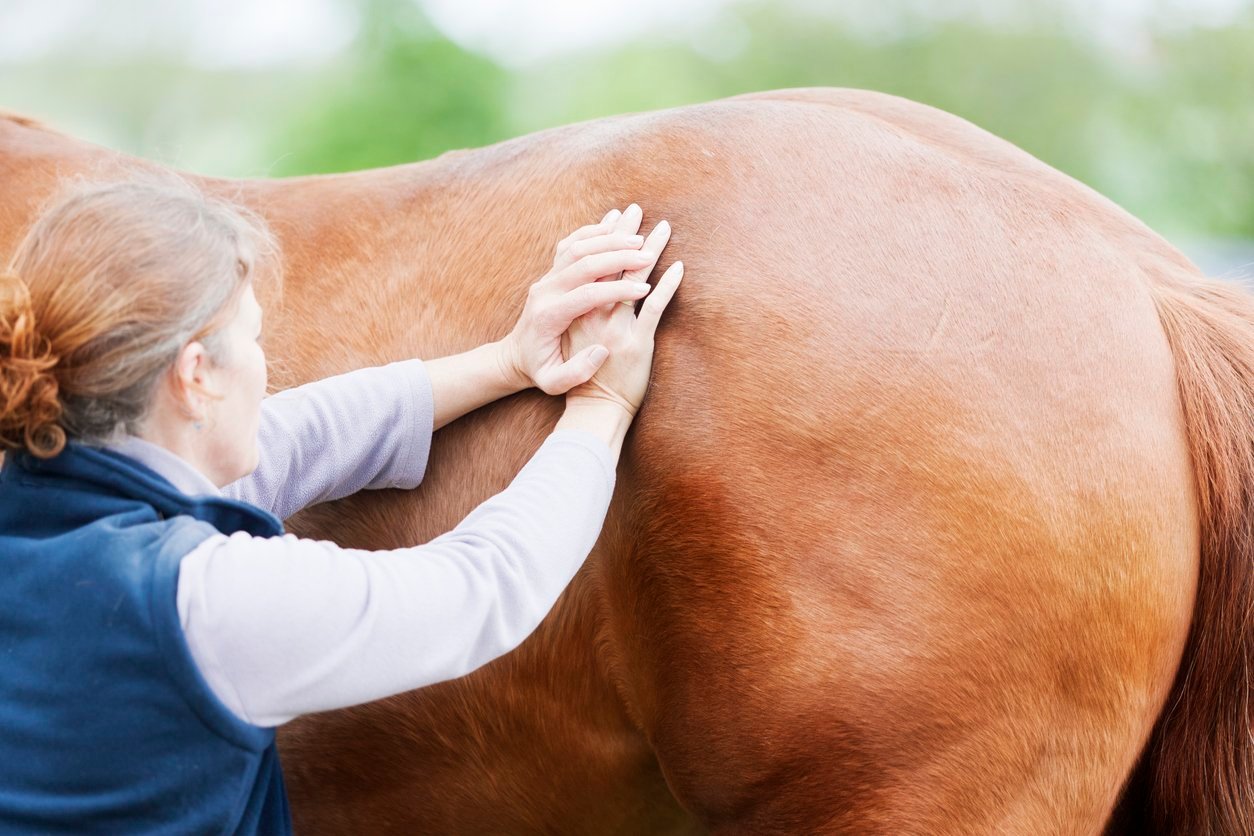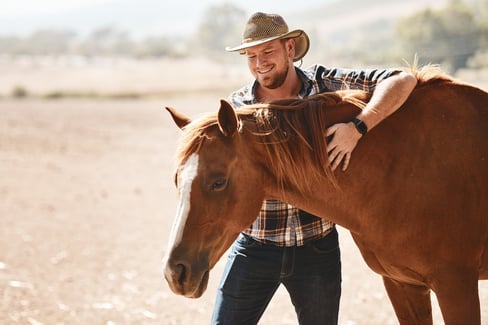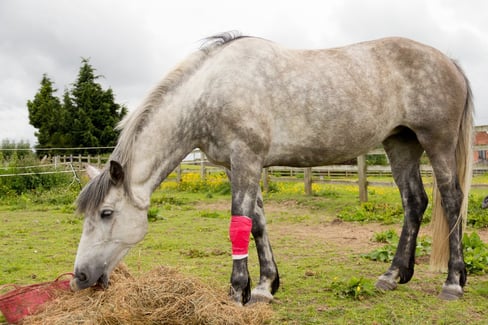Table of Contents
All joints are important, but when it comes to your four-legged friend’s performance, no joint is more critical than the SI joint in horses.
Allowing for movement to happen, the SI joint in horses can’t afford to become injured or impaired. It’s like the wind in a horse’s proverbial sails, and when it’s not functioning properly, you’re bound to have an unhappy, poorly performing horse on your hands.
That’s why we’ve got the details on taking good care of the SI joint in horses, how to spot SI pain in horses, and what exactly you can do to help prevent SI injury in horses.
Ready to get started? Let’s stop horsing around and get into it!
Definition of SI Injury in Horses
Before we can talk about how to spot an SI injury in horses, we’re going to give you a quick refresher on where exactly this critical joint is in their bodies, and how it works.
The horse’s SI joint functions like a motor, converting hind leg action into a forward motion, allowing it to gallop, run, jump, and trot. While you’d think that also means it’s a highly mobile joint, this joint actually has a limited range of motion.
The motion of your horse’s SI joint is supported by three strong ligaments that keep your horse upright:
- Dorsal sacroiliac ligament
- Ventral sacroiliac ligament
- Sacrotuberous ligament
So when you hear about SI joint injury in horses, it can be an injury to one of these ligaments, or the joint itself.
It is not uncommon for SI injuries to leave a joint less stable than it was originally, resulting in chronic pain in the long run that requires symptom management. SI injuries can occur through simple wear and tear, but the more mechanical stress the joint is subjected to, the greater the risk. For sport horses competing in activities like dressage, eventing, and show jumping, this is especially true.
Causes of SI Pain in Horses
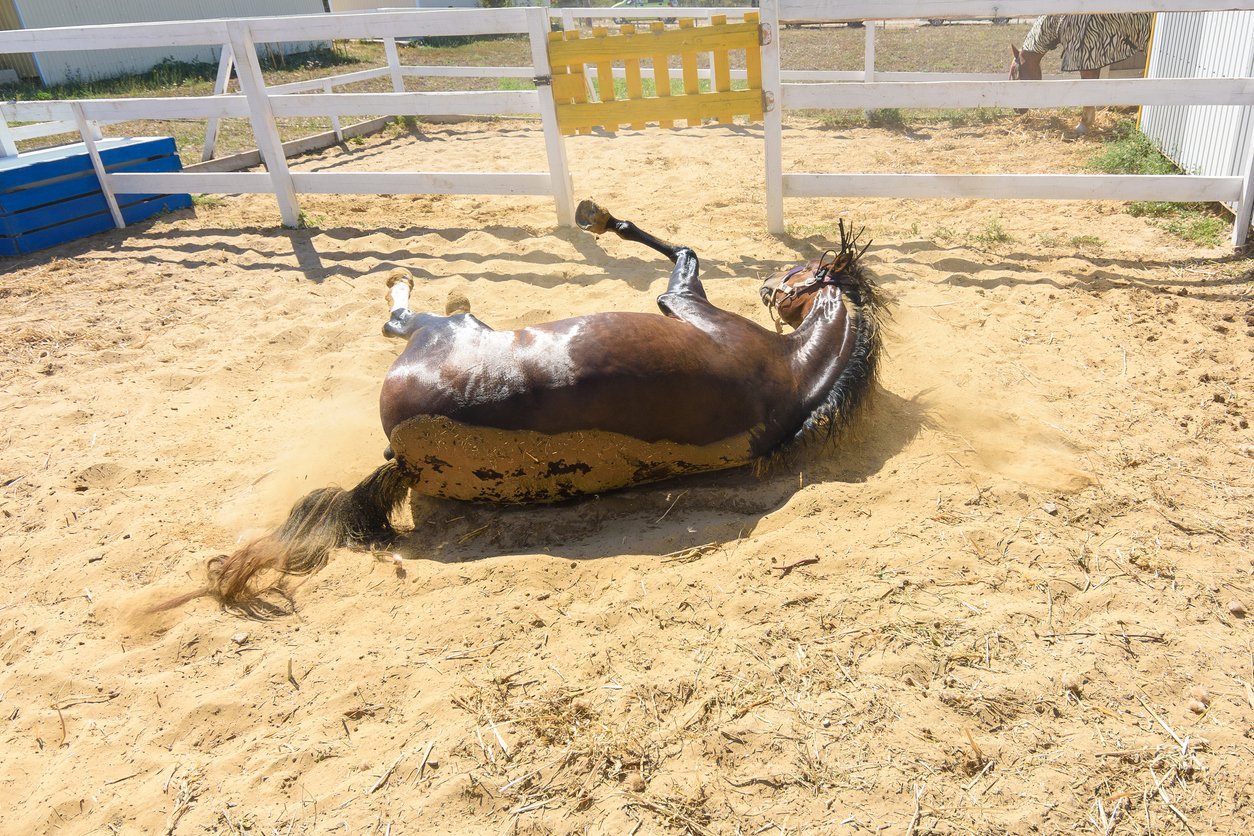
SI pain in horses can be caused by trauma or a degenerative condition like arthritis, among other reasons.
Anytime your horse’s SI joint is injured itself, or its surrounding ligaments and structures are, it can cause back trouble for your favourite companion. This includes things like suspensory ligament injuries, as these structures work closely together.
Generally, these injuries and strains can happen through:
- Development of osteoarthritis in the joint or surrounding structures
- Trauma from a fall
- Fractures and sprains
- Injuries caused by overstretching or excessive exertion
- Sacroiliac ligament desmitis
- Pain or injury to the stifle area
- Poor posture caused by rider position, hoof balance or saddle fit
Whether it is a secondary injury to the ligaments around the horse SI joint or the joint itself that seems to be injured, be sure to call a vet in to check on your horse if you witness an accident or traumatic injury to avoid long term pain and problems.
Symptoms of SI Pain in Horses
You need to be on the lookout for the signs of SI pain in horses. After all, this is one of the most critical joints in your horse’s body, so it only makes sense that avoiding an injury is also crucial to the success of any leisure or sport horse.
When you suspect an SI injury in horses, look for the following symptoms:
- Sensitive to touch or pressure on the lower back
- Stiff muscles around the SI joint
- A shorter hind leg stride
- Gait resembling “bunny hopping” or skipping
- Dragging of the hind leg toes
- Sudden or chronic lameness in one or more legs
- Gait coordination problems
- Deterioration of muscle mass in the hindquarters and rump
- Hunter’s bump that is disproportionately prominent or unbalanced
- Favouring one hind leg when standing, and shifting weight to compensate
- Kneecaps that click or lock
- Using the wrong lead leg, or being reluctant to strike off
- Inability to hold up the hind leg for shoeing
- Skin that is tender, itchy, and inflamed
- Sweating in patches
- Turning the tail to one side
As with anything out of the ordinary for your horse, be sure to call the vet if you spot any unusual behaviours or symptoms. That way, you can begin addressing the problem before it worsens for your horse.
SI Joint Problems in Horses
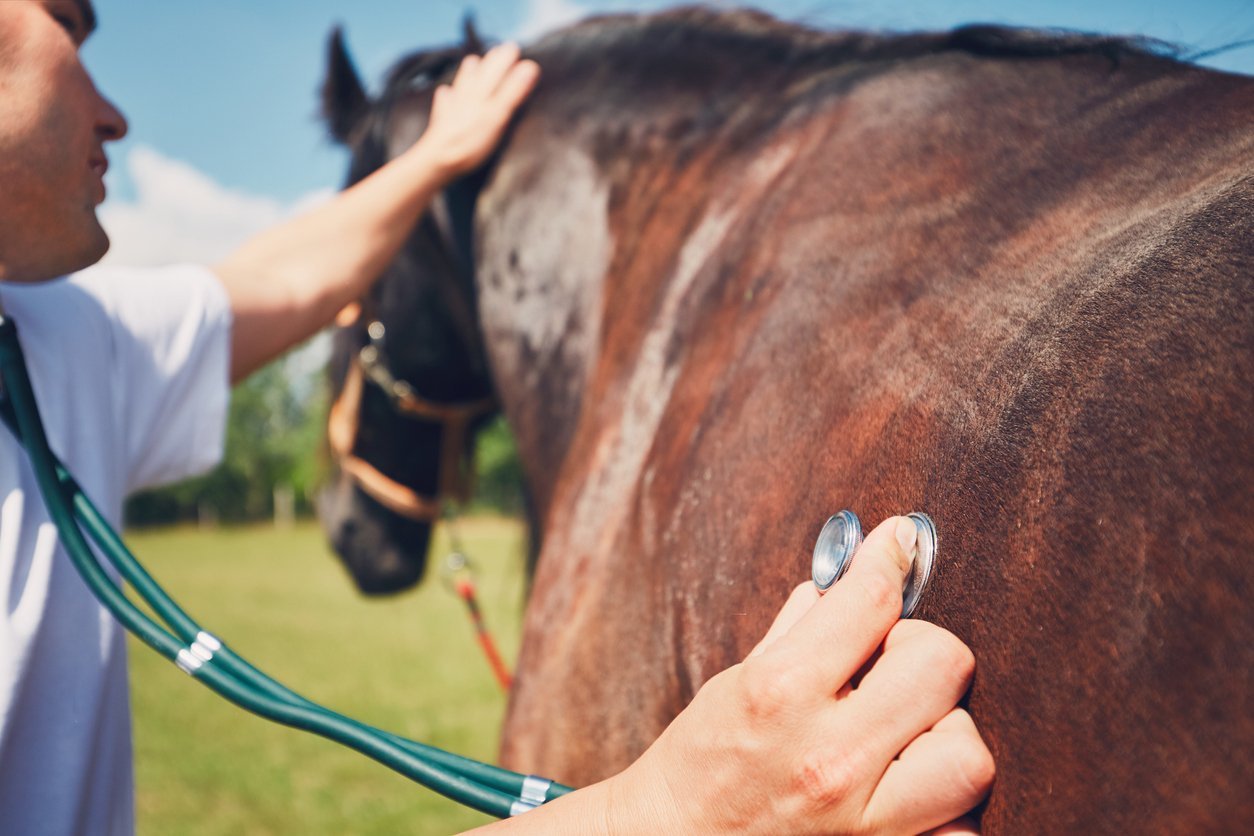
The root causes of SI joint problems in horses can vary, depending on what kind of activities your horse is getting up to, how you train, and even where you train.
That being said, we wanted to get into some of the specific reasons this joint commonly becomes a problem for your horse.
SI Injury in Horses
When it comes to SI pain in horses, one of the biggest culprits is direct trauma to the area. This can happen anywhere from the paddock to the starting line at a race.
You may notice signs of pain right away if your horse experiences an injury like a trip or fall, as symptoms tend to onset rapidly. Furthermore, any injury to the supporting ligaments can be painful and severely limit the horse’s movement. There are some cases in which a fractured pelvis can cause injury to the sacroiliac joints as they are interrelated and rely on one another to function. This means that even if the SI joint isn’t directly injured, your horse may still show signs of SI pain.
Training mistakes or poor conditioning can also cause SI pain in horses. Horses need to warm up cold muscles before exercising, rest appropriately, and avoid poor form when moving. That means giving your horse a good warm-up walk before training, turning your horse out in the pasture between training days and maintaining good posture.
SI Pain in Horses
When your horse has SI pain, you need to consider degenerative conditions caused by wear and tear just as much as acute trauma.
What we’re talking about here is arthritis. Osteoarthritis occurs when the joints become inflamed, ending in pain and stiffness for your equine pal. It occurs in older horses and those used for strenuous performance. Inflammation can result from injuries or infections that damage the bone surface. As a result of the friction between these damaged surfaces, your horse feels great discomfort. Joint supplements for horses can be helpful in both preventing and reducing the symptoms of arthritis.
Additionally, SI pain in horses can be associated with other hind limb injuries or conditions like locking stifle or sacroiliac ligament desmitis. To alleviate pressure on the other hindquarters where pain may be present, a lame horse will often compensate or carry weight differently, leading to more wear and tear on their SI joint, and potential injury.
SI Joint in Horses Prevention
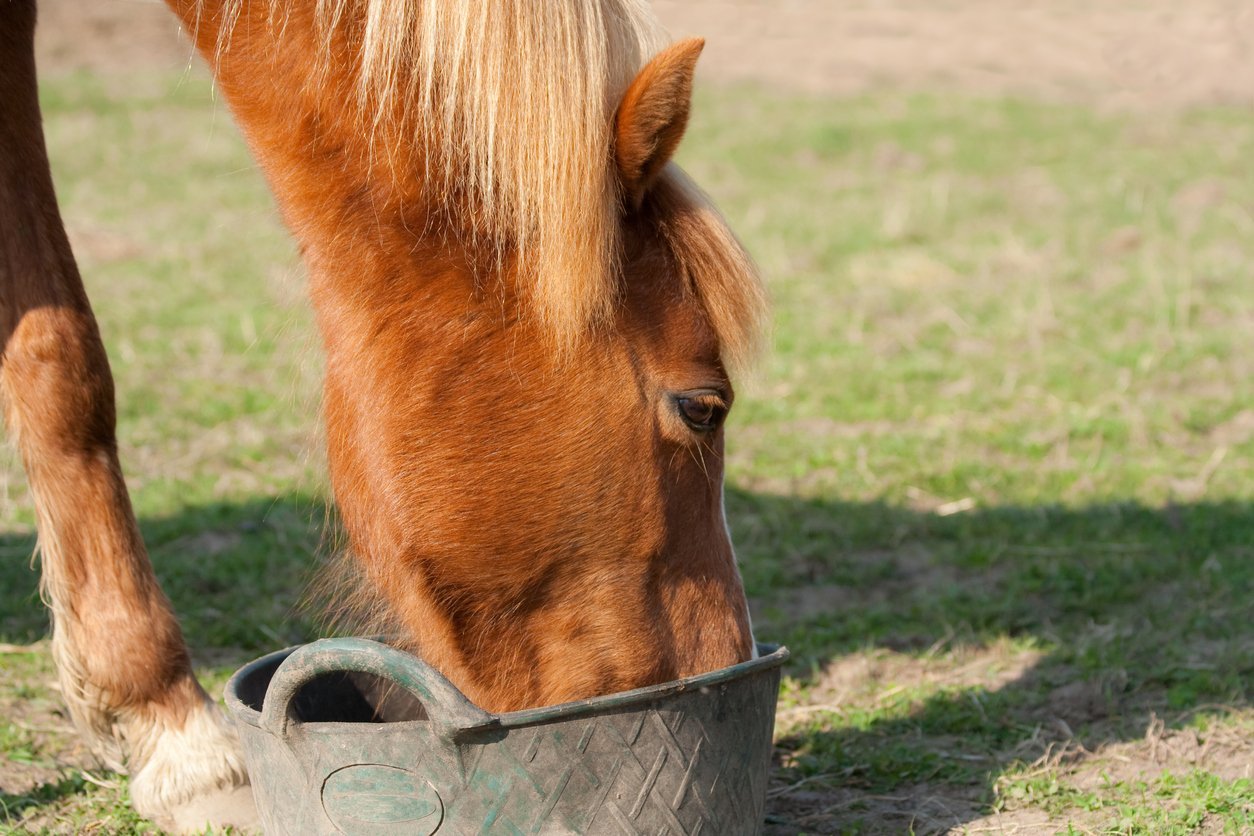
Who wouldn’t want to prevent their equine companion from the painful symptoms of SI joint pain in horses?
That’s why we’ve gathered up the best things to add to your toolkit that can help prevent SI pain in horses, and how they work to make sure your horse is feeling good and performing as normal.
Equine Joint Supplements
Ensuring your horse’s joints are strong and healthy is not only beneficial to the prevention of SI pain in horses, but to their overall health and performance.
Think of it as a house. When the foundation and structure of a house, often called “the bones”, is strong and well maintained, the rest of the home will be less likely to become damaged or in disrepair. The same goes for a horse. When their internal support systems, like the SI joint and its supporting ligaments, are well taken care of, your horse will be happier and healthier.
Consider using joint supplements with these ingredients to help support your horse’s overall joint health:
| Joint Health Ingredient | Benefit |
| Glucosamine |
|
| Chondroitin |
|
| MSM |
|
| Hyaluronic Acid |
|
Each of these ingredients plays a part in helping to alleviate the painful symptoms of SI pain in horses.
With seemingly endless choices on the market, however, how do you know which equine joint supplement is most beneficial to your horse?
You can start by learning how to read a supplement label. That way, you know exactly what you should look for in a supplement.
Any supplement worth its salt should:
- Contain glucosamine, chondroitin, MSM, and even hyaluronic acid
- Offer a small, easy to serve therapeutic dose
- Have zero fillers
- Have been tested by a third party, has been approved by Health Canada, and is designated as a Veterinary Health Product (VHP)
One supplement that meets these strict criteria, and even better, exceeds it, is Integricare’s TRI-ACTA line of products. TRI-ACTA offers high-quality ingredients that support the health of SI joints in horses, without breaking the bank. Plus, our maximum strength is TRI-ACTA H.A. supplement contains hyaluronic acid, which is beneficial for joint fluid and mobility.
TRI-ACTA H.A. for Equine
Our maximum strength formula is perfect for horses that are ageing, experiencing arthritis and stiffness, are in training and competition, or under a heavy workload.
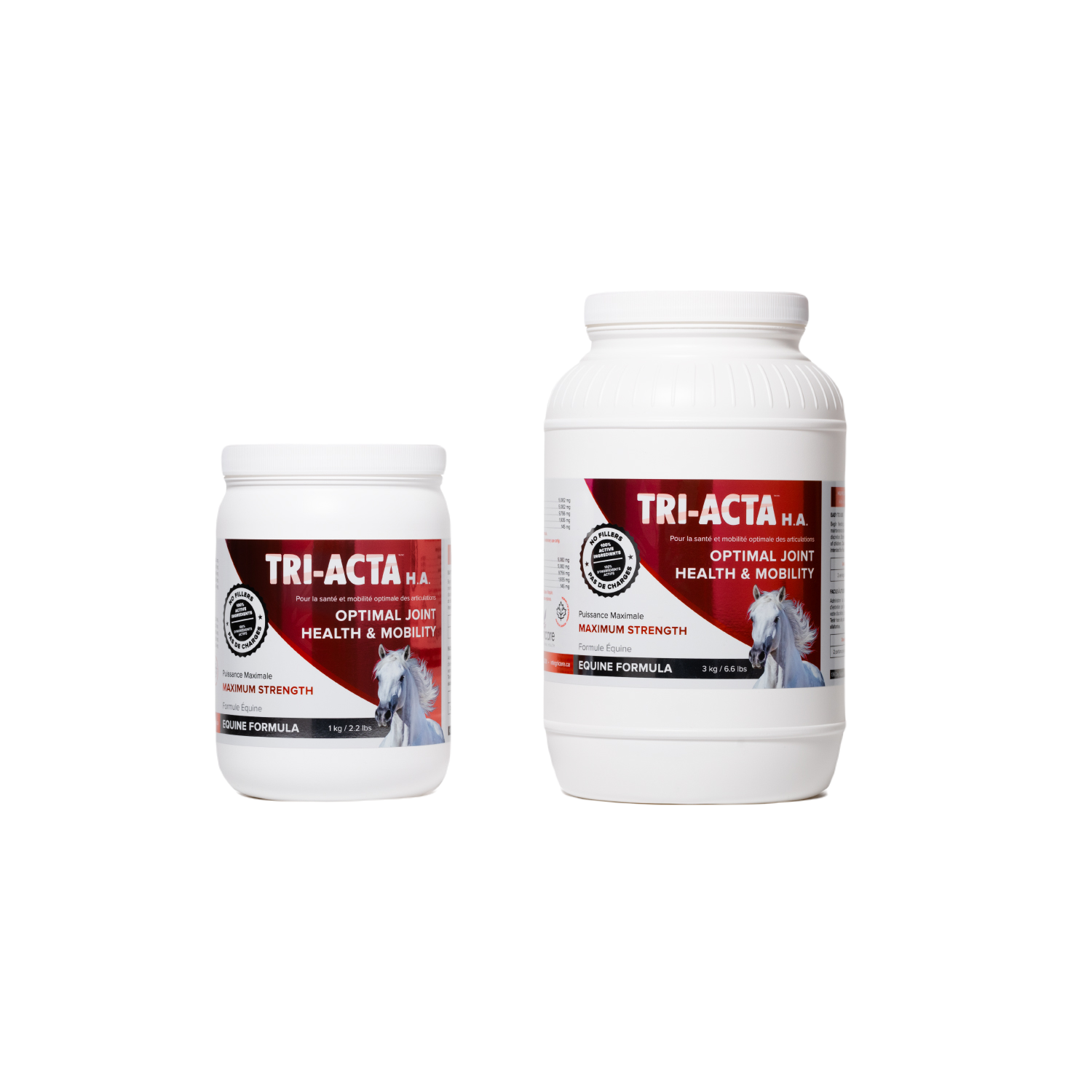
Balanced Nutrition
A balanced equine diet is the ticket to good overall health, and that includes the maintenance of the SI joint in horses.
When a horse experiences nutritional deficiencies, problems can arise that cause everything from acute symptoms to chronic pain and lasting problems.
For example, a horse who is deficient in critical vitamins like A, C, D, thiamine, riboflavin, or B12, can begin to experience symptoms such as:
- Changes and deficiencies in vision and eye health
- Increased sensitivity to pneumonia due to a weakened immune system
- An increase in appetite
- Progressive weakness of muscles
- Changes in their hooves
- Skeletal muscle damage
- Joint pain and swelling
In order to prevent a deficiency, you should be sure you understand what exactly is required in a horse’s diet, and what happens when that element of their diet is missing.
The table below shows the key parts of a horse’s diet, and why it’s important to both overall and SI joint health in horses.
| Component of Horse Diet | Why It’s Needed |
| Fat |
|
| Carbohydrates |
|
| Water |
|
| Protein |
|
| Vitamins & Minerals |
|
Controlled Exercise
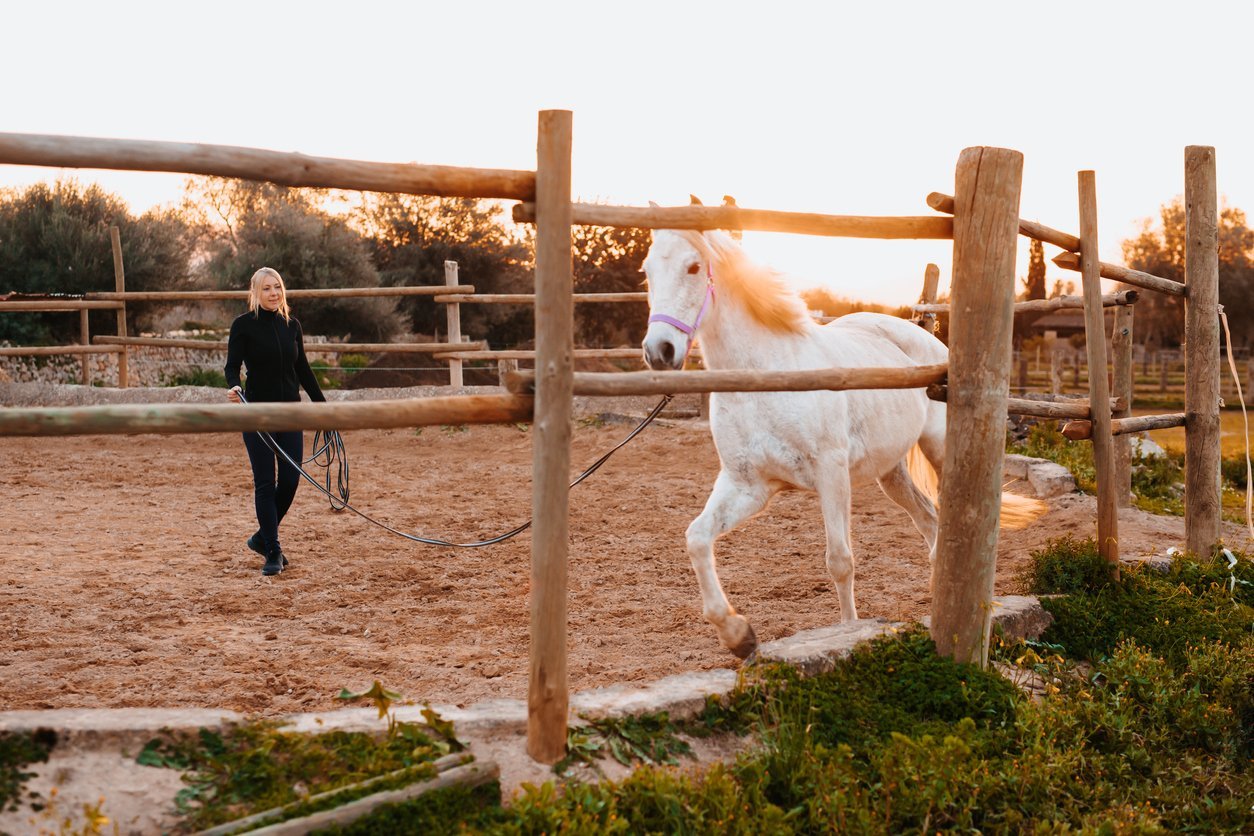
Training with a horse to prevent SI pain is focused on developing its hind muscles. Each exercise should be focused on getting the horse to pick up their feet in a normal arc when they take a step forward. By supporting the development of strong muscles in their pelvis and upper hind limb, you can ensure their SI joint is also well supported.
Some commonly used exercises to develop the horse’s hindquarters include:
- Exercises that improve flexibility and relieve tension
- Walking on a water treadmill
- Training with trotting poles and leg weights
- Strengthening supporting muscles with lunging aids
- Work on transitions under the saddle (walk to trot, trot to canter)
- Repeatedly hacking uphill, backwards, on small inclines
Be sure to consult with a vet or other horse pro, as an equine physical therapist, before you begin working on exercises like these. It’s important to establish if your horse has any current problems or SI pain to be aware of. That way, you can ensure the treatment plan for your horse is safe and effective. After all, you wouldn’t want to make your horse suffer further pain by choosing inappropriate exercises.
SI Joint in Horses Treatment Options
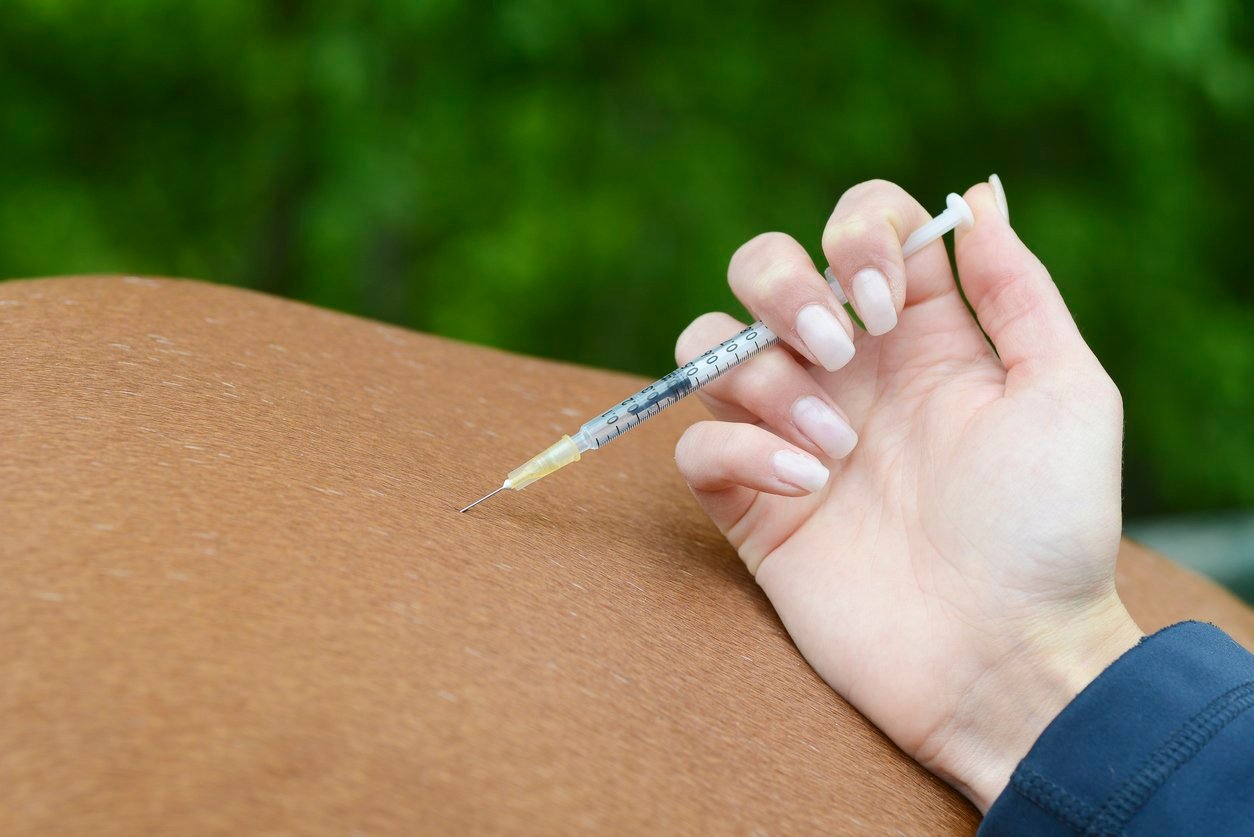
When prevention isn’t enough, due to existing injuries, the conformation of your horse, or the presence of arthritis, you need to know how you can treat SI pain in horses.
Thankfully, SI joint problems in horses are common, and there are plenty of solutions to ease their pain.
Just make sure you talk to your vet about what is going to be best for your horse specifically, before diving into any of these options.
SI Injections in Horses
SI injections in horses can provide your equine friend with targeted pain relief as you seek other techniques to heal their joints.
An injection into the sacroiliac joint typically contains both steroids and hyaluronic acid to treat both pain and mobility issues. Prior to administering injections, equine veterinarians usually administer a pain reliever and sedative together to ensure your horse is comfortable. A veterinarian will likely prescribe phenylbutazone to horses as part of the pre-operative procedure in order to keep them comfortable following SI injections in horses.
Both right and left joints may have to be injected, depending on the severity of your horse’s SI joint pain. In other cases, dealing with one joint at a time is sufficient. Your vet will be able to assess this, as well as if more injections could help further reduce symptoms.
Horses respond best to SI injections when they are combined with rest, physiotherapy, and supplements. Simply injecting them won’t solve all their problems. If you don’t address the true cause of SI pain in horses, you will encounter the same challenges again and again.
NSAIDs
Non-steroidal anti-inflammatory drugs are probably the most common medications used to treat SI pain in horses. NSAIDs are different from other anti-inflammatory drugs that contain steroids, including all cortisone compounds. One of the most common NSAIDs used in horses is phenylbutazone, also called bute.
Bute and other NSAIDs block inflammatory enzymes which help reduce the symptoms of SI pain in horses. It can be a fast, effective treatment for severe pain caused by trauma to the SI joint itself, or the surrounding structures.
NSAIDs in equine medicine are only available by prescription from your veterinarian and do carry some risks if used incorrectly. Long-term use or incorrect dosages and administration can lead to gastrointestinal issues, even in otherwise healthy horses. Be sure to follow the prescribed instructions from your vet, and don’t be afraid to pick up the phone if you begin to notice any out-of-the-ordinary behaviour from your horse.
Equine Joint Supplements
You know why the SI joint in horses can cause them pain, and you also know you need to treat the root cause of the problem.
But what exactly would that mean for the actual treatment plan for your horse?
In order for your equine companion to feel long term relief from the symptoms of SI pain in horses, you need to address:
- Inflammation
- Deteriorating cartilage
- Pain
- Mobility
Equine joint supplements like TRI-ACTA tackle all of those problems at the same time, at the source.
Each of those symptoms we mentioned above can be addressed with the help of joint health-supporting ingredients like MSM, glucosamine, chondroitin, and hyaluronic acid. Chondroitin prevents cartilage from breaking down. While glucosamine aids in cartilage repair, hyaluronic acid improves the viscosity of the synovial fluid. MSM reduces inflammation caused by irritation in the joints, relieving pain for your horse.
By tackling pain at the source, you can be sure that the symptoms of SI joint pain in horses are banished for good, and the rest of their joints and supporting structures are in tip-top shape, too.
TRI-ACTA for Equine
Providing preventative support for younger horses and helping mitigate the early onset of joint degeneration and other mobility issues.
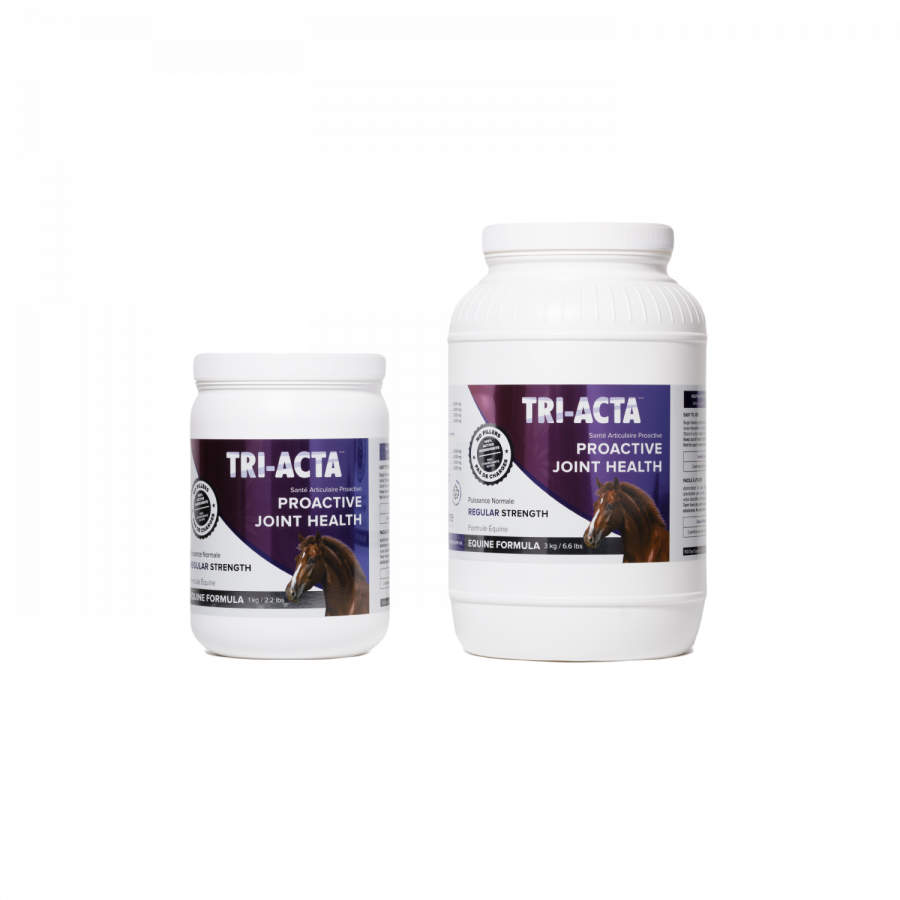
Rest

You may think it sounds strange, but rest is one of the best ways to help reduce symptoms of SI pain in horses. Even if you’re pursuing other treatments and medication, rest is an essential component of their treatment plan.
Rest helps reduce inflammation and stress on the joints. Typically, a minimum of one week is recommended to help reduce the symptoms your horse is experiencing. It can help other treatments like SI injections for horses work more effectively, as they are not creating further damage while resting. Especially if horses are involved in a performance sport like jumping where their sacroiliac joint is regularly stressed, their bodies need time to recover. Be sure to ask your vet what amount of rest would be best for your equine pal specifically.
Having said that, it doesn’t mean you should let your horse stay in the stall the whole time. If anything, it could make matters worse. After a few days of stall rest, you should turn them out in the pasture and carefully exercise them. Go for a short, gentle hand-led walk on even terrain, and be sure to monitor their symptoms while doing so. If you spot any sudden resistance or signs of pain, it’s time to return to rest.
Start Preventing SI Joint Problems in Horses
Proper nutrition and injury prevention alongside a balanced training and conditioning plan will help prevent SI joint pain in horses.
But the one thing that will help prevent and treat SI joint problems in horses is an equine joint supplement like Integricare’s TRI-ACTA line of equine supplements. With high quality, pharmaceutical grade ingredients in an easy to serve therapeutic dose that contains glucosamine, chondroitin and MSM, TRI-ACTA for Equine is the perfect preventative measure that will support your horse’s SI joint from the inside.
And if your horse is ageing, or already has an SI joint injury, you should consider feeding our TRI-ACTA H.A supplement. Offering the addition of hyaluronic acid, this formula helps keep your horse more mobile, and improves the quality of its synovial fluid.
Either way, you know there’s a neigh better option than TRI-ACTA for preventing and treating SI pain in horses.
TRI-ACTA H.A. for Equine
Our maximum strength formula is perfect for horses that are ageing, experiencing arthritis and stiffness, are in training and competition, or under a heavy workload.

Newsletter Signup
Subscribe to our newsletter to receive the latest news and exclusive offers.
.jpg?height=2000&name=Cliick_Integricare-DISPLAY-REVISEDV2%20(1).jpg)
Proactive & Therapeutic Joint Supplements
When given daily, Integricare joint supplements recover bone and joint injuries faster and help prevent mobility injuries from happening in the first place.

